by Eric Meier
In the process of identifying wood, things can get a bit overwhelming when faced with the hundreds and hundreds of possible species. Yet in the context of everyday woods that most people in the United States or Canada are likely to encounter, the list of possible woods is usually much shorter. This article is meant to act as sort of a “Cliffs Notes” to help address the most common (and hopefully, obvious) questions of wood identification.
1. OakComments: This wood is everywhere! Chances are, there’s something made of this wood within a stone’s throw of where you’re sitting right now. It’s used for cabinets, furniture, flooring, trim, doors, and just about anything else that can be made of wood! It’s very frequently stained a medium reddish brown, so it may look slightly darker than the raw sample pictured to the left. Lookalikes: Ash (lacks the prominent rays that are found in oak). Also, see the article on Distinguishing Red Oak from White Oak. |
|
2. MapleComments: This light-colored wood is seen almost as frequently as oak, and is usually not stained a dark color, but is kept a natural whitish-cream or sometimes stained an amber-yellow. It’s commonplace in furniture, flooring, trim, and in places where a pale, light-colored wood is needed. Quartersawn pieces with a freckled appearance are commonly used in countertops and butcher blocks. Lookalikes: Birch (generally has narrower rays than those found in maple). Pine (generally much lighter and softer than maple, and with more conspicuous color in the growth rings). Also, see the article on the Differences Between Hard Maple and Soft Maple. |
|
3. WalnutComments: The real deal. Walnut is unique in that it is one of the only woods that is naturally rich, deep chocolate brown (though it can sometimes be slightly lighter as well). It’s almost never stained, and is very popular for use in furniture. It’s also not uncommon to see walnut used in veneered pieces as well. Lookalikes: Mahogany (sometimes it’s stained very dark and the color can appear very similar to walnut). Butternut (sometimes called “White Walnut,” it’s related to walnut, but is paler in color and very lightweight). |
|
4. CherryComments: The subtle reddish brown appearance of cherry is usually seen on fine furniture and trim. It’s also not uncommon to see cherry used in veneered pieces as well. Along with Black Walnut it’s one of the premier hardwoods in the United States. It’s sometimes stained just slightly darker to give it a more aged appearance. Lookalikes: Poplar (stained poplar can be almost impossible to tell apart from cherry). |
|
5. BirchComments: Most commonly seen as plywood. Birch also tends to pop up in furniture and millwork too. Lookalikes: Maple (generally has wider rays than those found in birch). Cherry (the grain patterns are very similar, and if the birch is stained, it can be difficult to tell apart from cherry). |
|
6. PoplarComments: This is an inexpensive utility hardwood that’s used in a number of applications, such as upholstered furniture frames, veneer, and is also stained to mimic other more costly hardwoods. Lookalikes: Cherry (if poplar has been stained, it’s almost impossible to tell apart from cherry) |
Get the hard copy
 If you’re interested in getting all that makes The Wood Database unique distilled into a single, real-world resource, there’s the book that’s based on the website—the Amazon.com best-seller, WOOD! Identifying and Using Hundreds of Woods Worldwide. It contains many of the most popular articles found on this website, as well as hundreds of wood profiles—laid out with the same clarity and convenience of the website—packaged in a shop-friendly hardcover book.
If you’re interested in getting all that makes The Wood Database unique distilled into a single, real-world resource, there’s the book that’s based on the website—the Amazon.com best-seller, WOOD! Identifying and Using Hundreds of Woods Worldwide. It contains many of the most popular articles found on this website, as well as hundreds of wood profiles—laid out with the same clarity and convenience of the website—packaged in a shop-friendly hardcover book.

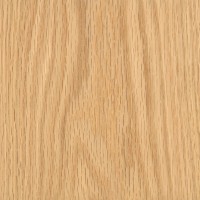
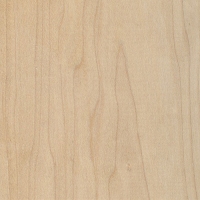
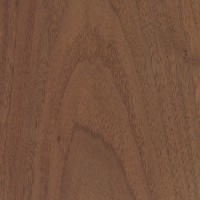
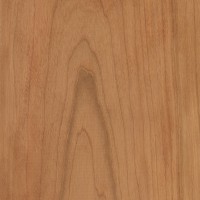
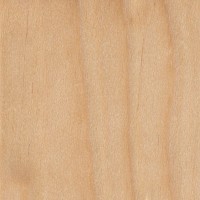
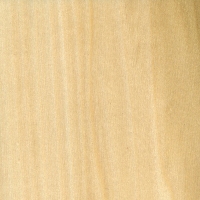



What type of wood is this? I’m thinking white oak (stained golden).Thanks very much!
I have been chainsaw carving this plank and it’s unlike any other wood I’ve ever worked with, the red/orange grain is pretty damn hard and the white layer is extremely soft and flakes easily. No idea what it is because I picked it up from an estate sale. Any help would be greatly appreciated! Cheers and thanks!
Looks like one of the denser US-native softwoods, like southern yellow pine or Douglas fir.
Could somebody identify the type of wood used on this table? I found this it at an estate sale and sanded down the top. There is quite a bit of water damage. I’m wondering what was used so I can stain it properly.
Looks like black walnut to me.
Hello! Trying to determine the wood used in an antique office chair (Milwaukee Chair Co., dated roughly 1880-1910). Fine and somewhat rare Captain’s Chair design. During restoration, removing old worn finish, the wood remained a reddish hue so I’m guessing cherry. Thanks for the help!
Can someone identify this wood for me?
That is a softwood. Possibly something like pine or fir.
Hello, I found this wooden tray in my shed. Would you be able to identify the species? From France. Thank you
I think it’s walnut. It’s smells like walnut.
Hello! Trying to find the type of wood used in this antique wood carving. I’m assuming it is a hardwood. Any ideas? Thanks in advance!
Looks like a softwood species, possibly something like pine or fir.
Thank you so much Eric!
I’m refinishing a chair with a “Made in Malaysia” sticker on it. I’ve sanded off the previous stain. It’s similar to poplar and birch. Any ideas?
Similar to poplar and birch with one very notable difference–there are large open pores in the wood. It looks like rubberwood to me.
Thank you, Eric! I believe you’re correct. Appreciate your time.
I live in Malaysia and rubberwood would be the most likely. We are one of if not the biggest cultivators of rubber trees in the world.
I am in the process of having our hardwood floors refinished. Also adding 750 square feet of new hardwood to match old. This hardwood sample I pulled up I planed down the stained top and cut both end and side for a clean look. I cannot tell if it is maple or birch. Hope you can help.
When looking at old hardwood flooring, regarding maple vs birch, I find it’s pretty hard to tell the two apart from a single board. What I like to do is just look at the entire floor as a whole. Usually, when taken as a whole, if its hard maple, there should be some small areas of birdseye figure somewhere on some of the boards. And with birch, there are usually a few pieces with a sort of broad undulating grain–similar to curly maple, but the “curls” in birch are just a lot wider and less pronounced.
Hello Eric, I really appreciate your input. I have attached a few more pics of my floor. I do not see any birdseye in the hardwood. The hardwood floor appears to me to possibly be birch and I am not certain of its quality. There are many indentations in the floor indicating a softer hardwood. Again I appreciate your advice. Take care -Brett
Picked up from a scrap bin at a local store. Not sure what it is. It is very hard and very heavy this piece is 8 pounds, and is 2 inches thick
Hello,
I was hoping that someone might be able to identify the wood that this bread cutting board is made from. Any ideas would be appreciated.
I have been working on refinishing a table for several months, and through my own research, have been trying (unsuccessfully) to identify the type of wood I am working on. I have owned the table for 40 years—I was told when I purchased it that it was mid 1800’s early American worktable. I have been using it as such and recently decided it deserved more respect! So I started on stripping and refinishing. As I begin to think about stain, I need to know the wood in order to determine how the stain will actually look—I see photos of a… Read more »
My husband is clearing out some trees from someone’s yard and this is off one of the trees. No leaves to help identify. The wood is yellow, but not Osage orange. Hard and dense. I’ve purchased an inexpensive 25x lens and tried to use the free apps, but still haven’t found a good match. Also included the bark.
Location is northeast Texas and the wood is still green (cut in last week or so)
Having you considered using a blacklight and checking for flourescence? You may be dealing with one of the species in this article: https://www.wood-database.com/locust-osage-and-mulberry/
Trying to identify the notched darker piece of wood. Suspect it may be pine but not sure if is or if it’s pressure treated.
I’m trying to identify this wood. This must have been an area unfinished under a wall.
Hello,
I am trying to identify the wood here on these chairs so I can repair/ replace the damaged veneer. Please help.
Thank you so much
Emmy
Not sure what kind of wood this Table is made of.
Desperately trying to identify the type of wood used in my home! Thanks in advance!!
Looks like a species of pine.
Oh my goodness, thank you SO much!!! It’s been driving me crazy trying to figure it out. We’ve been leaning towards it being a pine as well, it just doesn’t have the same smoothness as most pine. To be fair, wood is as old as our home, so well over 100 years old. Even after sanding, you can feel how raised the grain is. The dark parts are raised and solid–nothing happens when we do the fingernail test–but the light areas are lower and much softer–fingernail definitely leaves an impression. That’s had me extra confused since I truly know nothing… Read more »
I am trying to determine what wood this is
works good tight grain hard and slick
thanks
Oak
I’m curious as to what type of wood this is. I’m using it for a project and it’s beautiful, but I’m not 100% sure what wood to call it. Thank you.
If I had to restrict my guesses to only US commercial hardwoods, I’d say it’s black walnut.
Thank you for your reply. It’s not a commercial piece. People (landowners) cut down trees and brought them to my grandfather who was a woodworker. He’s passed and we still have so many different pieces of wood. But it definitely could be black walnut. Thank you!!!
Trying to identify this wood type from an old “hoosier” cabinet. This is a drawer sanded down. The grain resembles oak, but not sure it is … seems very smooth. Thanks for your help.
Looks like pine. Not oak.
Thanks. I haven’t uncovered any knots so far. The person who is stripping it for me thinks it is oak, but as I said, I am not convinced. Thanks again.
Oak and pine are very easy to tell apart if you know what to look for. Oak is a hardwood with large pores (almost like little straws running the length of the wood) especially along the growth rings. The wood in your picture has smooth growth rings with no visible pores, so a softwood of some type.
On the right side of the picture I see what appear to be resin canals occurring along the growth rings–visible as lighter little streaks against the backdrop of the darker growth ring.
Hi, I am trying to identify what type of hard wood floor this is. Thinking it is either hickory or some type of maple. Can anyone help please? Thanks!
The inverted colors around the growth rings looks a lot like hickory to me.
Hickory 100%
Price seems great ! But what is that wood ? Shop doesn’t know ..
It looks to be oak veneer. I say veneer because there is a solid strip of endgrain glued to the end, but if you look closely you’ll see that the board breaks (and overall grain orientation) doesn’t line up with the actual face grain of the wood. I think Ikea does this sneaky strategy sometimes too.
I’m trying to identify this wood for a friend. Any help would be greatly appreciated!
Trying to identify this wood from old dresser
Softwood. Probably Pine
Any help in identifying this wood.Originally probably from a deck. Wood is very heavy.
Looks like red oak straight from the mill. Could you plane or sand a bit of the oxidized layer off to reveal the rays?
My front door…sanded it and realized it was stained….looking to figure out what the wood is…thanks
Once again I’d have to guess red oak. The rays seem quite pronounced so that’s what I’m making my guess off of. I’ve seen many old oak doors. Being stained though, I could never be certain.
That’s mahogany. It was commonly used for trim and doors in the ’70s.
I found these under a breezeway from the prior owner. Any idea what kind of wood they are? Thank you in advance. -kim
Hello, this is a very interesting site I did not know there was such a thing except taking in a piece of wood physically and in Miami that’s not the easiest thing to find. I was trying to identify this piece of wood I don’t have any idea where to start with this. It was given to me by my girlfriend who says her parents has had it as long as she can remember she’s my age so that’s 53 and really not sure what it is,if it’s natural, if it’s manufactured. I know they like collecting interesting pieces of… Read more »
That looks to be a stunning piece of petrified drift wood maybe. It’d be really hard to tell the type but I think a good place to start would be a museum. Have a density test done. I read awhile back that a collage would be happy to do the necessary test. I hope you figure it out
I’m trying to figure out what type of wood this is. It was used inside a covered greenhouse at a HS in NY and has been there for a long time.The weight is between cedar and pine. The color is dark brown all the way through(no stain). No obvious scent.Thank you for any guidance.
Hi – I’m trying to identify what type of wood these “carriage style” garage doors are made of. This is from a house in eastern Pennsylvania, built in 1928. I’m posting a picture of a freshly cut side of the door. They are quite heavy. I’m thinking maybe oak but would love an expert opinion. Thanks!
The surface is too rough to make out enough detail.
Oak is always my first guess when it comes to old doors but I’m not seeing the rays. I agree with eric, more detail could be seen if you plane or sand a bit of it. The gold at the bottom near the knot makes me lean towards pine.
Hello, I am repairing an old stair railing and would appreciate help identifying the type of wood. This is a new england home built in 1850. Most of the railing is in tact but one section has been butchered. The assembly is all done with mortise and tenons with wooden pins (hand rails to newel posts). I need to rebuild some tenons that have been cut away and would like to use the same wood. The wood is a medium brown color is not very heavy. I am attaching pictures of one of the remaining tenons (side and end grain)… Read more »
Looks like some type of mahogany. Given its age, it may be Cuban or Honduran of the Swietenia genus. Though there’s also a chance it could be African (Khaya genus). Endgrain image doesn’t show enough clarity / detail to check for marginal parenchyma bands.
I would appreciate any help identifying what this wood might be. It is part of an old wall in my house that was built in 1712. I have uncovered a wood wall that I want to carefully uncover.
Looks like a stained softwood, such as spruce or fir.
was that a commonly used wood to build with in New England in the early 1700’s? Here are some more pictures of the wall I am slowly uncovering.
I can’t tell the exact species or genus, just that it’s a softwood of some sort. In general terms, yes, softwoods have been popular for building and structural applications since the trees tend to grow tall and straight.
Could anyone make a suggestion? I have a bubinga grand piano. It’s on the reddish side. I would post a picture but it’s out being serviced. While we do that we are having built in cabinet and shelves put in. We are looking for some wood for the counter between the two. I would like a suggestion on what wood would be most ideal for this project. I would love to do it in bubinga as well but sourcing it would take too long and the cost would probably be as much as the entire project. I like the grain… Read more »
I think unless it’s being subjected to a higher amount of wear (such as flooring or a tabletop), maple should be more than adequate for shelving. Also, with a little bit of inquiry, there are sources that sell hard maple with the curly figure rather than soft maple.
What wood is this from Portugal
One thing I can say that could be helpful, is that it’s a softwood of some sort, not a hardwood. I’m not familiar with what would be commonplace in Portugal, but construction softwood species would be the best place to start.
Looks like Douglas Fir
Looking for some help to identify this timber. It came from a stack of bed slats but with a mix of some really different timbers, amongst of which included some Panga Panga and some figured timber, so I think they were offcuts of the maker who reused them for bed slats. This is quite a dense and heavy stick measuring 90mm wide x 15mm thick
Found this at old house in NH. Was painted I sanded it down. Pictures are from the same pc but two different sections. Can you tell ne what it might be? Thank you Dave
Given the age and location, I’d say it’s probably a species of southern yellow pine, sometimes referred to as antique heart pine in contexts where the wood is very old.
I believe it is Southern Yellow Pine
Would you be so kind as to help me w this slab?
Are these two different pieces of wood? What’s the story behind these pics?
They are the same slab but it sanded and stained top but not the bottom. Got this in N CA and it’s heavy and very dense. I thought he said at the time it was shipped from East
Hmm, well it’s pretty confusing because it appears that both the top and the bottom are stained, but just different colors. I maintain the the bottom is also stained an even darker color. In the upper left part of the image, even the sanding scratched are a dark brown color, which would only occur in a stained piece where the pigment is getting embedded into the vertical sanding scratches. It looks like a ring porous wood, and based on the jagged parenchyma lines on the face grain, my best guess would be some type of elm, though I’d need to… Read more »
Here is the other board, with same dimensions as the other: 10? wide, 1? thickness (after planing), and 8? long, and also found in the basement, used as shelves. This one is distinctly yellow, as you can hopefully see from the photos. Both of them seem to be hardwoods, from my best estimation.
Looks like one of the golden colored hardwoods that are easy to get mixed up. Can’t tell enough from the pics to ID, but this article should help: https://www.wood-database.com/locust-osage-and-mulberry/
Thank you Eric, I can’t tell you how excited I am to have a better idea of what I’m working with! I was really stumped by the golden color, but this narrows it down.
Hi Eric, I’ve enjoyed your articles and have learned a great deal from them! I was wondering if you could help me identify two boards; the first one is shown below. Both boards were found in my basement, rough cut, when I bought the house, and used as rudimentary workshop shelves. The house was built in the 60’s and we bought it 8 years ago. The boards are both 10″ wide, 1″ thickness (after planing), and 8′ long. The photos shown are after I planed them up. Thank you in advance for your help!
Oak. I’m guessing from the darker discoloration it may be red oak, but not 100% sure.
Found this wood in my basement. It was being used on a set of pylons to hold other material. The boards on the left came from a single piece that was 16 feet long, 11 inches wide and 1.5 inches thick. I cut it into four pieces. The boards on the right came from a piece that was 8 feet x 4 1/4 x 1 1/8. Here is a picture of the wood that shows the end grain. It was not stained. The wood had to have been there over 50 years (it was very likely put there by my… Read more »
Looks like a softwood of some sort. Possibly Douglas fir.
Ok. Thank you.
Hello!
Could you please help me identify this wood? Thanks in advance!
Looks like a softwood, such as spruce or fir.
Pls help me identify this wood.
Looks like cedar
Can anyone tell me what kind of wood is used on this ceiling? Thanks so much for your help
Hi, can anybody help identify this wood? Thank you
Looks to be European ash. It’s like a yellowish, semi-hardwood. If you could see the bark, it’s very coarse and gray. I’ve made electric guitars out of the European ash I’d felled; not a bad sounding tonewood, but somewhat stubborn to work.
Attached is a Tele style I’ve yet to make a new k for. European ash, common “problem tree”, US, and a small, stained vase.
… While we’re on the ash thing:
I thought I’d throw in this interesting cache of stock. This, as it turns out, is black ash from a neighbor’s cut-down tree. Quite a bit harder and far prettier than the European ash.
Attch: knife handle for f-hole carving knife and a piece of milled stock
I bought a new house and not sure about the flooring. Is there any way you guys can help me understand the flooring type so that I can maintain it accordingly.
Thanks.
this is a french work stool top from France; they made this model from the 30’s through the 50’s. I know it’s a plywood from that era, 13/16″ thick. A small section is missing ,and I want to replace it but not sure what hardwood is the “A” face. wood is has very straight and “raised” grain pattern
It could possibly be some old growth oak that has very closely spaced growth rings. It’d be pretty tough to find a 1:1 replacement today that would match. I would focus more on getting a good stain color match. Possibly there are pieces of ash that could have tighter grain like that which you could stain to match.